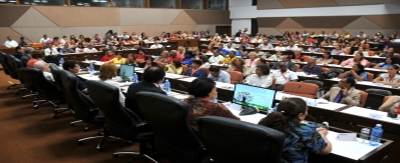España/Autora: Nati Bergadá
Como maestros, a menudo ponemos en duda nuestras habilidades, destrezas y metodologías de trabajo. Nos preocupamos por si hacemos bien nuestro trabajo o por si atendemos de la mejor manera nuestros alumnos.
Esto es muy bueno y demuestra que queremos hacer el máximo de bien nuestro trabajo, que somos exigentes con nosotros mismos y que nos preocupamos por nuestros niños. Esta exigencia es la que nos hace mover, nos hace estar activos y probar nuevas maneras de hacer y interaccionar con los alumnos.
Yo me hago a menudo estas preguntas y por eso decidí hacer una lista de los que, para mí, son los retos que tenemos por ser buenos maestros. Espero que te parezcan interesantes.
Los 62 retos
A continuación encontrarás un listado de los retos que como maestro / a te puedes proponer realizar en tu día a día en la escuela.
- Acompaña tus alumnos.
- Felicita siempre, viva el refuerzo positivo!
- Sonríe MUY cada día.
- Dialoga, conversación y pacta.
- Escucha los niños.
- Establece vínculos con tus alumnos.
- Promueve el aprendizaje activo.
- Sé flexible y adáptate a las circunstancias.
- Mujer libertad a tus alumnos.
- Sorpréndete descubriendo nuevos conocimientos.
- Promueve la igualdad y respecto a tu aula.
- Disfruta de cada clase tanto o más que los niños.
- Aprende de tus alumnos.
- Re-inventa tu manera de enseñar.
- Despierta en los alumnos el interés por aprender.
- Propicia la interacción, la colaboración y el trabajo en equipo.
- Enseña a tus alumnos a ser competentes.
- Sé positivo y verás siempre el vaso medio lleno.
- Ama los niños.
- Percibe la diversidad de alumnos como riqueza.
- Concibe al alumno / a de forma global.
- Enseña con buen humor.
- Ábrelos la puerta al mundo.
- Plantéate nuevos retos que te motiven.
- Sé cariñoso y cercano con los niños.
- Emociónate sin miedo.
- Permite a los alumnos que aprendan haciendo.
- Llénate de paciencia.
- Piensa que la mejor respuesta es una buena pregunta.
- Confía en tus alumnos.
- Promueve la libertad y la democracia en tu aula.
- Enseña a los alumnos a pensar.
- Demuestra complicidad con los niños.
- Potencia la autoestima de tus alumnos.
- Sé creativo y promueve la creatividad.
- Ponte en el lugar de los alumnos y los entenderás mejor.
- Descubre el potencial de cada niño.
- Enseña a tus alumnos a resolver conflictos.
- Disfruta de cada pequeño momento.
- Enseña a tus alumnos a saber estar y saber esperar.
- Potencia que los niños tengan pensamiento crítico y reflexivo.
- Observa los alumnos y te sorprenderás.
- Si estás nervioso, respira y ve agua.
- Trabaja la cultura del esfuerzo.
- Potencia que los niños se relacionen.
- Sé sincero con los alumnos, ellos te lo valorarán.
- Disfruta del trabajo en equipo entre compañeros.
- Mantente activo y fórmate continuamente.
- Lee mucho y transmite el gusto por la lectura.
- Sé ordenado y tus alumnos también lo serán.
- Trata con respeto a los niños y exige lo mismo de ellos.
- Propicia un buen ambiente de convivencia en el aula.
- Enseña hábitos a tus alumnos.
- Procura por su bienestar.
- Comparte lo que haces con los otros maestros.
- Ten siempre esperanza.
- Sé coherente y justo con los alumnos.
- Trabaja conjuntamente con las familias.
- Potencia las habilidades de tus alumnos.
- Ventila el aula y crea un ambiente agradable de trabajo.
- Promueve que los niños experimenten y descubran.
- Trabaja el espíritu de superación.
conclusión
Hacer de maestro / a no es un trabajo llana en la que cada día sabes qué pasará cuando comienzas la jornada. El hecho de trabajar con niños y convivir con otras personas, maestros y familias, hace que la escuela sea una red social compleja y llena de vida. Cambia constantemente y siempre te sorprende.
Un día marchas de la escuela contenta y feliz sintiendo que es un privilegio poder hacer el trabajo de maestra. Poder ver con ilusión que los niños aprenden y disfrutan haciéndolo. Hay momentos mágicos en los que un niño, sólo con una mirada o con una pequeña frase te emociona.
Pero también hay días, por suerte pocos, en los que marchas de la escuela triste, enfadada y dudando de todo. Días en los que, sin haber un motivo aparente, no ha habido buena sintonía con los alumnos, con los compañeros, con las familias …
Estos días te recomiendo que cojas aire y intentes pensar en positivo. Lee estos 62 retos y no te desanimes. Ten claro lo que representa para ti ser un buen maestro y sé fiel a esta creencia. Esto te ayudará a no perder tus objetivos y verás como al día siguiente volverá a brillar el sol: ser maestro / a es un privilegio!
Por último me gustaría citar una frase de Jaume Cela que encuentro muy acertada «Los maestros deben abrir puertas, acompañar, acoger y, sobre todo, escuchar a los alumnos.»
Fuente noticia: https://translate.google.co.ve/translate?hl=es&sl=ca&u=http://natibergada.cat/&prev=search
Fuente imagen: http://4www.ecestaticos.com/image/clipping/992/558/45b4190a7b3318ca5a9a4b268d4f505d/la-educacion-espanola-explicada-por-sus-protagonistas.jpg















 Users Today : 2
Users Today : 2 Total Users : 35460211
Total Users : 35460211 Views Today : 3
Views Today : 3 Total views : 3418898
Total views : 3418898